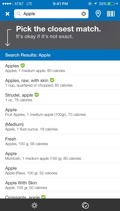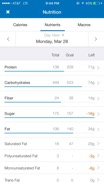So you’ve made the decision to track your nutrition. Congratulations! Meal tracking can improve one’s diet, promote more mindful eating behaviors, provide lots of new information for your benefit as well as for your doctor or dietitian and ultimately, lose more weight! MyFitnessPal (a popular app available for both iPhone and Android) is an easy and effective way to track what you eat.
Getting Started
 After downloading the app and signing up using your email or Facebook, you are encouraged to provide basic information such as your age, weight and activity level.
After downloading the app and signing up using your email or Facebook, you are encouraged to provide basic information such as your age, weight and activity level.
This will help you establish a goal (such as losing, maintaining, or gaining weight) as well as the rate at which the weight change will occur. These factors will determine the app’s recommendation for your daily caloric intake.
Related: want some other apps or resources for tracking nutrition? Check out this post!
Track Your Diet
 Now you can start tracking! Using the diary page, you can input new information by pressing the blue + button on the bottom of the screen or the “add food” button under specific meals. The + button allows for you to input food as well as other information like status with progress photos, water, exercise, and weight.
Now you can start tracking! Using the diary page, you can input new information by pressing the blue + button on the bottom of the screen or the “add food” button under specific meals. The + button allows for you to input food as well as other information like status with progress photos, water, exercise, and weight.
One of the most useful aspects of MyFitnessPal is their enormous database containing most food items that can be bought from stores. Your phone’s camera can also scan the barcode of almost any packaged food item and the database will usually have it stored! However, be careful to specify the number of servings you eat, as many packaged food items contain multiple servings.
As you track your meal through the day, the equation on your diary page will update to keep you informed on your progress. The more exercise you get in a given day, the more you will have to eat to compensate for those burned calories. Exercise can be factored into the equation automatically using your phone’s ability to count steps or compatible devices such as Apple Watch or Fitbit.
To see your breakdown of caloric intake per meal, nutrients and macros (carbs, fat, protein) click “Nutrition” while in the diary tab. Track your weight over time to further motivate yourself! You can also input other information like BMI and body fat %.
5 Tips for Maximum Results
Use the “recent” food tab.
When inputting food in your MyFitnessPal diary, use the “recent” tab for foods you eat regularly. You can also group ingredients as a custom meal to use in the future. Over time, time spent tracking your meals should decrease significantly!
Say no to diets, just eat mindfully.
 Studies show that people who subscribe to “fad diets” often do not succeed with their weight loss goals. At the end of the day, companies care most about making money by selling you products. Doing your research, tracking your diet, and eating more mindfully can be done without paying anyone (and is much cheaper, especially given that MyFitnessPal is free!)
Studies show that people who subscribe to “fad diets” often do not succeed with their weight loss goals. At the end of the day, companies care most about making money by selling you products. Doing your research, tracking your diet, and eating more mindfully can be done without paying anyone (and is much cheaper, especially given that MyFitnessPal is free!)
Remember that everyone’s macros will be different.
Keep in mind that everyone is different – different people will function best with different ratios of carbs and protein. Carefully monitor the way you feel and function after different meals – these experiences and results are uniquely yours!
Use the barcode scanner.
The barcode scanner is your friend! When I began to track my meals I was excited about the bar code scanner and the potential to track exactly what I ate. So for one day, I only ate food that came in packages I could scan. I cooked once that day but was sure to scan every ingredient using exact measurements. These rules dictated that I could not mindlessly eat a handful of chips or chug orange juice from the carton because everything had to be measured out precisely. I immediately learned about how to eat more mindfully.
Share the data!
The nutrition data you collect over time should be immensely helpful for your doctor, registered dietitian (did you know we have a full staff of RDs at FFC?), or other healthcare professional. Nutrition is one of the biggest indicators of overall health and it is currently very rare that patients have complete logs of their diets. If you are experiencing health problems potentially related to nutrition and your current health care professional is not knowledgeable about nutrition and primary prevention, find another who is.
The more you track, the more motivated you will be!
Post written by FFC contributor Andy Devries.
